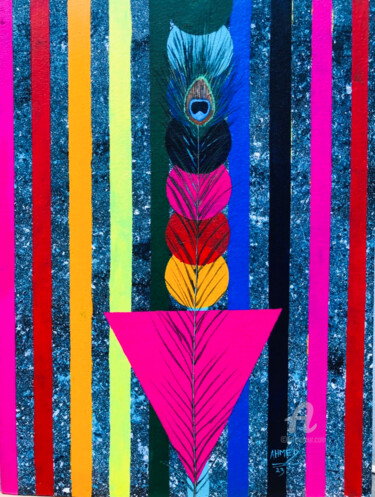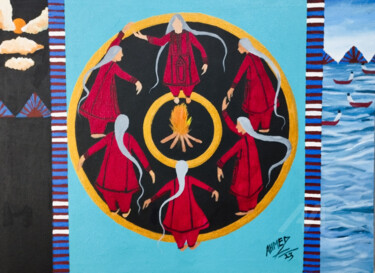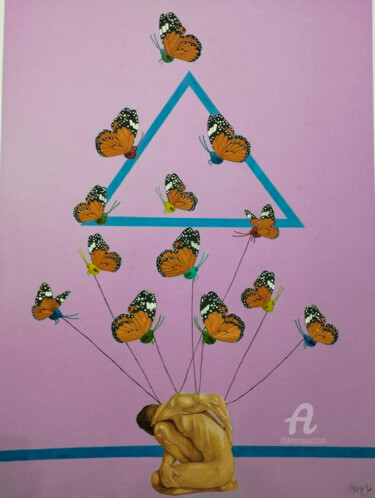Ahmed Khan
Ahmed khan was born on 2nd January 1990 in Teertaj Awaran Balochistan. He was worked in the art council Quetta from 2011 to 2012. In 2012, he took admitted to Baluchistan University in the fine arts department. In 2013 he left the university of Baluchistan and took admitted to CEAD Mehran University of Engineering and Technology, Jamshoro. He passed his graduation on 26 December 2016 with a specialization in miniature painting. He was awarded with the silver medal in his batch. He has done his M.A (Hons) in visual art from the National College of Arts (NCA), Lahore in 2019. He exhibited his work in Karachi, Jamshoro, Hyderabad, Lahore, Islamabad, Turbat, Hub Chowki, Awaran, Lasbela, Quetta, Gwadar, and more importantly in Berlin Germany. Besides this, he is famous for his performing art and has credit for being the first kathak dancer in Balochistan. Therefore, Ahmed Khan is known for his multidimensional nature of work which includes performing arts, miniature, painting, and applying different mediums of work.
Discover contemporary artworks by Ahmed Khan, browse recent artworks and buy online. Categories: pakistani contemporary artists. Artistic domains: Painting, Digital Arts. Account type: Artist , member since 2018 (Country of origin Pakistan). Buy Ahmed Khan's latest works on ArtMajeur: Discover great art by contemporary artist Ahmed Khan. Browse artworks, buy original art or high end prints.

Artist Value, Biography, Artist's studio:
Exclusive selection at discounted prices • 1 artwork
View allLatest Artworks • 39 artworks
View allSold Artworks • 15 artworks
Recognition
Editor's Pick
The artist's works have been noticed by the editorial staff
The artist's works have been noticed by the editorial staff
Presented in Art Fairs
The artist participates in art shows and fairs
The artist participates in art shows and fairs
Professional Artist
Exercises the profession of artist as a main activity
Exercises the profession of artist as a main activity
Biography
Ahmed khan was born on 2nd January 1990 in Teertaj Awaran Balochistan. He was worked in the art council Quetta from 2011 to 2012. In 2012, he took admitted to Baluchistan University in the fine arts department. In 2013 he left the university of Baluchistan and took admitted to CEAD Mehran University of Engineering and Technology, Jamshoro. He passed his graduation on 26 December 2016 with a specialization in miniature painting. He was awarded with the silver medal in his batch. He has done his M.A (Hons) in visual art from the National College of Arts (NCA), Lahore in 2019. He exhibited his work in Karachi, Jamshoro, Hyderabad, Lahore, Islamabad, Turbat, Hub Chowki, Awaran, Lasbela, Quetta, Gwadar, and more importantly in Berlin Germany. Besides this, he is famous for his performing art and has credit for being the first kathak dancer in Balochistan. Therefore, Ahmed Khan is known for his multidimensional nature of work which includes performing arts, miniature, painting, and applying different mediums of work.
-
Nationality:
PAKISTAN

- Date of birth : 1990
- Artistic domains: Works by professional artists,
- Groups: Professional Artist Pakistani Contemporary Artists

Ongoing and Upcoming art events
No data available yet
Influences
No data available yet
Education
2018 - 2019
MA Hons in Visual Art
Lahore,
Punjab,
Pakistan
2013 - 2016
BFA
Jamshoro,
Sindh,
Pakistan
Artist value certified
No data available yet
Achievements
Collective Expositions
2022
Meraki
Karachi,
Sindh,
Pakistan
2022
Female Alliance
Islamabad,
Capital of Pakistan,
Pakistan
2022
Wadaar ( Waiting) 0.2
Islamabad,
Capital of Pakistan,
Pakistan
2022
Women Expo Show
Turbat,
Balochistan,
Pakistan
2021
Peepal &Amp; Banyan
Berlin,
Berlin,
Germany
2019
M.a Hons Degree Thesis Display
Lahore,
Punjab,
Pakistan
2019
The Edge
Lahore,
Punjab,
Pakistan
2019
We Have Been Waiting For You
Lahore,
Punjab,
Pakistan
2018
Young Artist Show Alhumara
Lahore,
Punjab,
Pakistan
2017
Young Artist Show Alhumara
Lahore,
Punjab,
Pakistan
2017
National Show Pnca
Islamabad,
Capital of Pakistan,
Pakistan
2017
Regional Show Pnca
Karachi,
Sindh,
Pakistan
2017
Baad E Saba
Karachi,
Sindh,
Pakistan
2017
Colours Of Youth
Karachi,
Sindh,
Pakistan
2016
Bfa Thesis Display
Jamshoro,
Sindh,
Pakistan
Solo Expositions
2021
Wadaar ( Waiting)
Hub chowki,
Balochistan,
Pakistan
2020
Sky Is Pink 0.2
Turbat,
Balochistan,
Pakistan
2019
Sky Is Pink
Karachi,
Sindh,
Pakistan
Activity on ArtMajeur
Last modification date : Apr 1, 2025
(Member since 2018)
Image views: 28,463
Artworks by Ahmed Khan added to favorite collections: 48
Latest News
All the latest news from contemporary artist Ahmed Khan
Added Feb 22, 2023
In Pakistan’s Balochistan, a man carries torch of ancient dance form of Kathak
 SearchIn Pakistan’s Balochistan, a man carries torch of ancient dance form of KathakPrevious
SearchIn Pakistan’s Balochistan, a man carries torch of ancient dance form of KathakPrevious Ahmed Khan, who goes by the stage name Ahmed Ibn Sakina, performs kathak dance on the eastern mountains of Quetta, Pakistan, on March 16, 2022. (AN Photo)NextShort Url
Ahmed Khan, who goes by the stage name Ahmed Ibn Sakina, performs kathak dance on the eastern mountains of Quetta, Pakistan, on March 16, 2022. (AN Photo)NextShort Url
https://arab.news/8dbex
Ahmed Khan, who goes by the stage name Ahmed ibn Sakina, was captivated by classical music as a childKhan has MPhil from Pakistan’s prestigious National College of Arts, says he's undeterred by stigma, abuseUpdated 24 March 2022SAADULLAH AKHTARMarch 24, 2022 08:00
QUETTA: Ahmed Khan first heard classical music as a young boy while accompanying his father as a shepherd in the mountains of the impoverished Awaran district in southern Pakistan.
As the tunes played on a portable radio, the eight-year-old boy was mesmerized by the rhythmic beat of the tabla and felt himself tapping along. There began a dancing career that led him from watching videos online to becoming the first person from the deeply conservative Balochistan province to get an MPhil degree from the prestigious National College of Arts (NCA), and pursue a professional career in Kathak, a classical dance form rooted in Hindu mythology and traditionally considered the preserve of women.
“I think I am the first [Kathak] dancer in Balochistan, there is no other performer who has come forward,” Khan, 32, who goes by the stage name Ahmed Ibn Sakina, told Arab News as he tied an anklet bearing dozens of tiny bells on his bare feet and got ready to practice his craft on a mountaintop bordering Quetta city.
Kathak, one of eight classical dance genres in India, is over 2,000 years old, according to some historians, and was performed in royal courts in the Mughal era, finding favor among both Hindu and Muslim traditions.
The genre’s lineage is associated with three cities in India: Lucknow, Banares and Jaipur.
“I perform the semi-classical Kathak dance attributed to the Lucknow Gharana [household] in which a kathakar performs with his hands, facial expressions and feet,” Khan said, explaining that ‘katha’ was the Sanskrit word for storytelling.
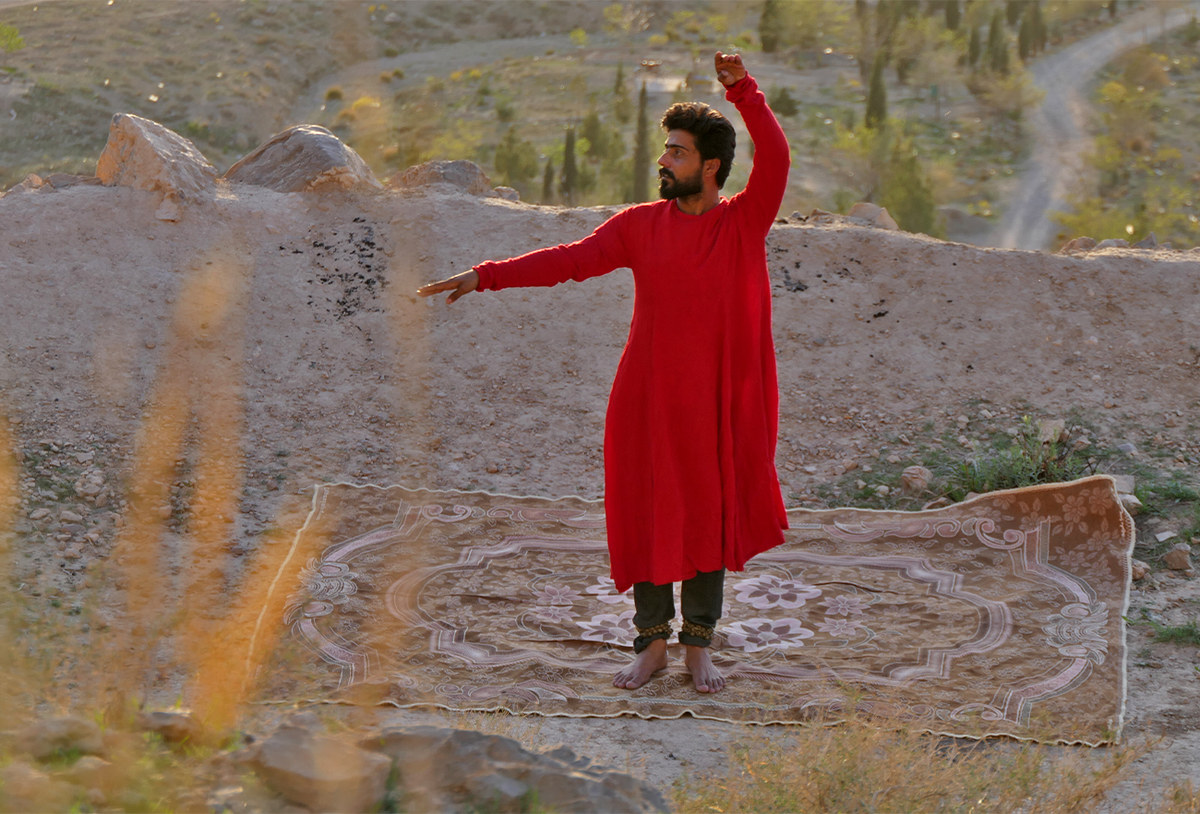
Ahmed Khan, who goes by the stage name Ahmed Ibn Sakina, performs kathak dance on the eastern mountains of Quetta, Pakistan, on March 16, 2022. (AN Photo)
After he graduated from NCA, Khan had many offers to teach dance elsewhere in the country but decided to return to his home province.
“I thought I should go to Balochistan, whatever I have learnt I should teach it to the people of Balochistan,” he said. “But most people in this region know very little about performing arts or realize their significance.”
Though Khan’s family supported his passion for dance, he said he was ridiculed by his friends and cousins who could not grasp the idea of a male Kathak dancer. In recent years, he said he had also faced threats of death and sexual violence on social media.
But Khan said he had stood up to such abuse from a very young age, and was undeterred by it, even using the customarily female name Sakina, his mother’s, as his identity on stage.
“I have received many threats,” he said. “People use fake IDs to say we will kill you, when you come to Quetta, we will make you dance naked.”
The dancer smiled gently: “People keep talking but if I get intimidated by what people say I won’t be able to live. People don’t even want you to live.”
His teacher and former Pakistani actress Zareen Panna said people like Khan deserved encouragement and support.
“Kathak dancers like Ahmed, who belong to underprivileged regions, must be promoted in Pakistan,” she said, “since they get fewer opportunities than people who are based in other cities.”
The chief minister’s adviser on culture, Abdul Khaliq Hazara, said the provincial administration was keen on promoting the arts in Balochistan.
“Every existing culture in this world has a unique history which goes back hundreds of years,” he said. “I have seen Ahmed’s performance in a private function which was astonishingly good, but I unfortunately did not get a chance to meet him again.”
Meanwhile, Khan said he wanted to get a doctorate in Kathak from India where leading masters of the craft taught students from across the world, though he currently did not have the resources to pursue this dream.
“My primary source of income is my dance performances,” he said, as he began his rhythmic footwork on the mountaintop, “but I barely earn Rs30,000 a month through them.”
Added Feb 22, 2023
Ahmed Ibn-e-Sakina — first male kathak dancer from Balochistan on a quest for peace
Kathak is one of the eight major forms of Indian classical dance. The word Kathak has its roots in the Sanskrit word ‘Katha’ which translates to story or tale. It is traditionally regarded to have originated from the travelling bards of North India referred as Kathakars or storytellers.
Ahmed-ibn-e-Sakeena, hailing from Awaran, Balochistan, is the first male semi-classical Kathak dancer who rose to prominence for his masculine energy, balanced posture, flexibility, facial expressions and elegant hand movements. Ahmed pursued his basic education from his native area and graduated from Mehran University of Engineering & Technology in Centre of Excellence in Art & Design. Thereafter, he travelled to Lahore to get an MPhil degree from the prestigious National College of Arts (NCA), and pursue a professional career in Kathak.
“I have been fond of dancing since my childhood,” says Ahmed. Even though he didn’t know the forms of dance, he still kept dancing and moved his body to the rhythmic beat of the songs played on a portable radio and eventually, he discovered this classical dance form of Kathak in 2012 which, he says, paved his way to a dancing career.
Following his unique artistic talent and family’s support, Ahmed has been emerging as one of the finest Kathak dancers in Balochistan. He said people had made a mockery of the concept of a male Kathak dancer.
“People have labelled me as ‘sex worker’, ‘gay’, ‘impotent’ etc,” he says with saddened, but unsurprised emotions. “Because I belong to a highly conservative region and here people know little about the significance of arts and cannot grasp the idea of this classical Kathak dance,” he explains.
He said he had frequently received verbal abuse and death threats on social media through fake IDs. “At times, online abuse and harassment plunged me into depression,” he remarks. “It took a huge toll on my mental health as well.” Ahmed says he was vulnerable to suicidal tendencies and was even about to commit suicide, but he was lucky to have encouraging friends who stood by him and boosted his morale. “They pushed me to sail through my artistic journey,” he narrates.
“When would people understand artists, too, are human beings and can become sad and depressed through social media abuse and harassment?” he asks in a heart-breaking tone.
Ahmed concedes to the fact that it is not easy for him to challenge gender stereotypes and overcome all obstacles. But he is committed that he won’t be intimidated into abandoning Kathak dance. “I won’t relinquish Kathak dance because it is the part of my existence. And I am a warrior and I would combat all odds. Threats and abuses cannot shatter my confidence. I would emerge stronger instead,” he says in a fearless tone.
Concerning the background of dance in Baloch society, dance is considered as a cultural taboo. Not only Ahmed-ibn-e-Sakeena, but also many Baloch prominent singers like Nako Faizuk, Nako Sabzal, Arif Baloch were criticised widely for dancing along with singing songs. On the other hand, the Baloch educated class is fighting hard to overcome this cultural taboo and acknowledge the dance as an ‘art’.
Hailing from a war-torn province of Balochistan, Ahmed strongly aspires to be an ambassador of love and peace in order to spread happiness and bring smiles on people’s face. He aims to travel in every nook and corner of Balochistan in order to promote this Kathak dance and spread peace. He believes Kathak dance is all about love, peace, prosperity and happiness.
“Dance can be used to convey the message of love and peace. It can be a compelling tool to neutralise warmongering opinions and counter a bloody conflict because dance carries an emotional appeal for peace,” Ahmed emphasizes the significance of peace over conflict through dance. Kathak dance is the form in which, he believes, he can blend his emotions, tell a story, convey a message, spread peace and prevail love. He adds that the Kathak dance feels like a magic and casts a spell on the audience which results into evocation of one’s internal state of peace and satisfaction.
He grieves that the negligible contribution of Balochistan government in promotion of artistic talents is adding to the woes of the artists. The lack of resources and disengagement by the government is affecting the efficiency of artistic works. “I struggle to continue Kathak dance as a professional career. I don’t have adequate resources to chase my dream,” Ahmed mourns but is still confident on making his way in one or the other way.
People often invite him in various events and tell him to dance freely for them. “I hardly earn Rs 10,000 in a single event which sometimes take place in two or three months,” he says
Given the Shariah perspective on Kathak dance, renowned Mufti Naeem, based in Quetta, asserts that any form of dance accompanied with music is forbidden in clear terms in Islam.
“Music and dancing are haram in Islam. Those who consider it ‘halal’ are actually committing Kufr,” says Mufti. Dance tarnishes the honour and dignity of a person, he maintains. He says that dance is, in actual, an ‘animalistic characteristic’ which carries random jumping from one place to the other place. “It can never be regarded as legitimate and permissible in Islam.” Ahmed didn’t deny the Islamic point of view. He said that everyone had their own opinions and perspectives and he didn’t have the authority to alter other doctrines. “But if you view it from the artist’s point of view, dance is an art,” he firms his view, adding that dance serves as a food to the soul and strength to the heart and acts like a soothing balm, while religious scholars view it as a sin. “It is all about diversity of perspectives when it comes to dance,” Ahmed says. A poet, fiction writer, critic, a translator and professor at University of Balochistan, AR Dad said that Kathak dancer like Ahmed-ibn-e-Sakeena is a ray of hope in the Baloch society who is breaking the barriers and making a difference with his masculine energy following classical Kathak dance.
“Kathak dance is an essential ingredient of life and is a poetry of the body,” Dad puts forward. Kathak is truly secular in concept and people often unknowingly incorporate this dance with religion by relegating it to a form of lewd entertainment and branding it as un-Islamic and immoral, he continues. “That’s why, it is a fast diminishing art form in Balochistan.”
Dad says it is a good omen that educated people like Ahmed are coming to the fore and promoting this classical dance which is a great medium to convey a message of love and peace. Dad adds it might take years to break deeply-seated social stereotypes and change the archaic mindsets prevailing in Baloch society regarding Kathak dance, but Ahmed could make a huge impact if he beats all odds courageously and performs Kathak dance without any fear. He could pave the way for the generations to come.
Ahmed-ibn-e-Sakeena conveys a message to the people that artists and Kathak dancers, being ambassadors of peace and love, deserve a degree of respect and security from the society. In fact, a world without artists can never be imagined. Artists and Kathak dancers have embarked upon a journey to spread the message of peace and love across the world. Let all of us show respect to them, shower love upon them and support them throughout their journey. Let’s all celebrate our artists and Kathak dancers.
The writer is a freelance journalist based in Quetta
Reviews and comments
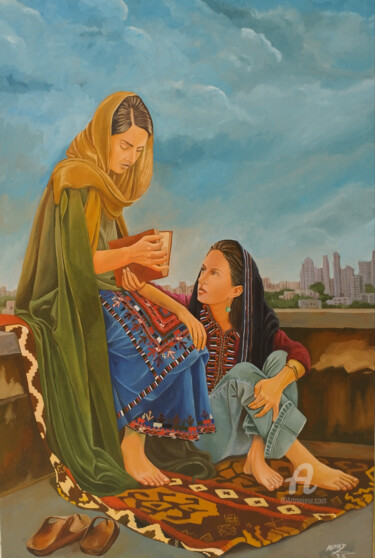
©2023 Ahmed Khan
Great work. I love the colors here. Warm and gentle.
Thank you so much 😊🙏🏼
My pleasure your work is amazing
Thanks for adding my work.
Contact Ahmed Khan
Send a private message to Ahmed Khan






